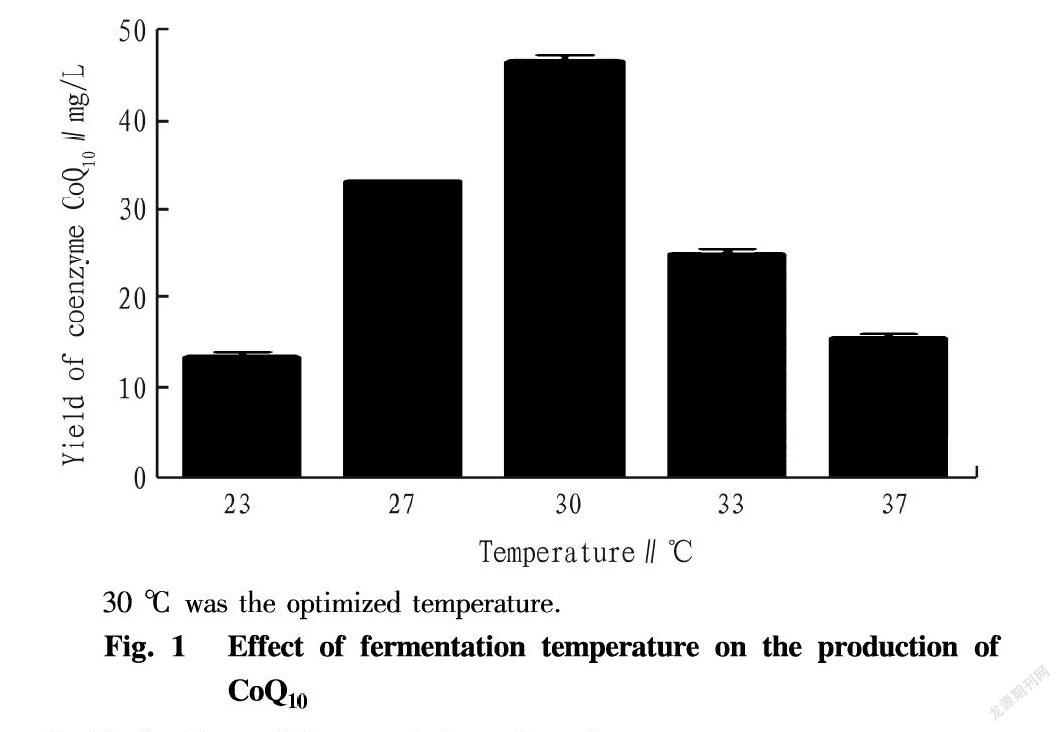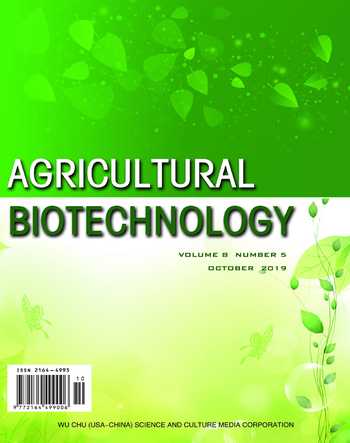Optimization of Coenzyme Q10 Production Procedure from Rhodobacter sphaeroides Overexpressing UbiE
Kuo TANG Zhiping ZHAO Li ZHANG Zhenhui KANG




Abstract In the present study, single factors including inoculation amount, fermentation temperature, fermentation duration and ratio of fermentation medium volume to total flask volume were optimized for enhancing the production of coenzyme Q10 from genetic engineered Rhodobacter sphaeroides overexpressing UbiE. The experimental results suggested that optimal single factors were: inoculation amount 2%, fermentation temperature 30 ℃, fermentation duration 48 h, and fermentation medium volume to total flask volume 80%. The present study will promote the large scale production of CoQ10 from microorganisms.
Key words CoQ10; Rhodobacter sphaeroides; Genetic engineering; Optimization; Fermentation
Coenzyme Q10 (CoQ10) is a lipid-soluble material wide-spread in both prokaryotes and eukaryotes. In recent years, the demand for CoQ10 is becoming more and more because of its multiple functions such as antioxidation and transferring electron in the electron transport chain[1]. Because of the important biological roles, CoQ10 is well-used in food, cosmetic and pharmaceutical industry. Microbial fermentation is becoming one of the most promising way to produce CoQ10. Rhodobacter sphaeroides is a gram-negative bacterium that is rich in CoQ10 and proven to be an excellent microorganism to produce CoQ10[2-3]. In our previous study, an UbiE-overexpression R. sphaeroides was constructed[4], and the production procedure was optimized to increase the CoQ10 production from the genetic engineered R. sphaeroides.
Materials and Methods
Growth conditions
R. sphaeroides strain was grown at 30 ℃ in malate minimal medium[5]. Growth under micro-aerobic conditions was performed as described in our previous study[6]. 1.5 μg/ml of tetracycline was added to the growth media for the genetic engineered R. sphaeroides overexpressing UbiE.
Effects of inoculation amount on the yield of CoQ10 from the screened genetic engineered strain
A single colony was inoculated into a 50 ml-flask containing 40 ml of malate minimal medium and grown under micro-aerobic conditions in the dark at 30 ℃ until OD660 reached 0.6. Pre-cultures were inoculated into five 100 ml flasks containing 80 ml of malate minimal medium at the ratio of 1%, 2%, 3%, 4% and 5% and grown under micro-aerobic conditions in the dark at 30 ℃ for 48 h. CoQ10 was extracted from the cell cultures and quantified as mentioned above, respectively. The experiment was repeated three times.
Effects of fermentation temperature on the yield of CoQ10 from the screened genetic engineered strain
A single colony was inoculated into a 50 ml-flask containing 40 ml of malate minimal medium and grown under micro-aerobic conditions in the dark at 30 ℃ until OD660 reached 0.6. Pre-cultures were inoculated into three 100 ml flasks containing 80 ml of malate minimal medium at the ratio of 1∶50 and grown in the dark at 27, 30 and 33 ℃ for 48 h. CoQ10 was extracted from the cell cultures and quantified as mentioned above, respectively. The experiment was repeated three times.
Effects of fermentation duration on the yield of CoQ10 from the screened genetic engineered strain
A single colony was inoculated into a 50 ml-flask containing 40 ml of malate minimal medium and grown under micro-aerobic conditions in the dark at 30 ℃ until OD660 reached 0.6. Pre-cultures were respectively inoculated into five 100 ml flasks containing 80 ml of malate minimal medium at 2% and grown in dark at 30 ℃ for 36, 48, 60, 72 and 84 h. CoQ10 was extracted from the cell cultures and quantified as mentioned above, respectively. The experiment was repeated three times.
Effects of oxygen tension (fermentation medium volume to total flask volume) on the yield of CoQ10 from the screened genetic engineered strain
A single colony was inoculated into a 50 ml-flask containing 40 ml of malate minimal medium and grown under micro-aerobic conditions in the dark at 30 ℃ until OD660 reached 0.6. Precultures were respectively inoculated into five 100 ml flasks containing 50, 60, 70, 80 and 90 ml of malate minimal medium at 2% and grown in dark at 30 ℃ for 48 h. Different volumes of fermentation medium in the flasks will lead to different concentrations of dissolved oxygen at a steady rotation speed. CoQ10 was extracted from the cell cultures and quantified as mentioned above, respectively. The experiment was repeated three times.
Results and Discussion
Optimization of fermentation temperature
The fermentation temperature was optimized for the genetic engineering strain, as revealed in Fig. 1. Among the temperatures ranging from 23 to 37 ℃, the CoQ10 production increased with the increase of temperature. However, the CoQ10 production at 33 and 37 ℃ was lower than that of at 30 ℃. Clearly, 30 ℃ was the optimized temperature for production of CoQ10 from the genetic engineering strain, with the yield of 46.462 5 mg/L. Compared with the CoQ10 production at 23 and 27 ℃, the CoQ10 production at 30 ℃ increased by 248% and 40.6%, respectively. However, the production of CoQ10 at 33 and 37 ℃ decreased by 46.2% and 66.7%, respectively.
Optimization of fermentation duration
The fermentation duration was measured for the genetic engineering strain, as seen in Fig. 2. The production of CoQ10 was tended to be enhanced from 24 to 48 h for fermentation. The production of CoQ10 fermented for 24, 36 and 48 h, was 18.958 1, 29.254 8 and 39.743 5 mg/L, respectively. Compared with production fermented for 24 and 36 h, the production fermented for 48 h increased for 109% and 35.9%, respectively. However, the production of CoQ10 decreased when fermented duration was over 48 h. The production of CoQ10 fermented for 60 and 72 h was 32.204 2 and 15.799 3 mg/L, respectively, which decreased by 18.97% and 60.25%, respectively, compared with the fermentation duration for 48 h. It is reasonable to speculate that fermentation duration for 48 h was the optimized fermentation duration.
Optimization of inoculation amount
The results for the inoculation amount are shown in Fig. 3. Clearly, the inoculation amount affected the production of CoQ10 from the genetic engineering strain greatly. The yields of the CoQ10 were 29.11, 35.61, 28.98, 17.77 and 18.09 mg/L when the inoculation amounts were 1%, 2%, 4%, 6% and 8%, respectively. The production of CoQ10 reached the highest when the inoculation amount was 2%, which was nearly 2 times of the CoQ10 production when the inoculation amounts was 6% and 8%.
Optimization of medium volume used in flasks
The medium volume to the flask will change the resolved oxygen in the fermented medium. All the expression vectors are constructed based on the pRKpuf vector, harboring the puf operon promoter which is one oxygen tension dependent[7]. At high oxygen tension, the PpsR repressor will be bound to the promoter. However, at low oxygen tension, the PpsR repressor will be bound with the anti-repressor protein AppA and thus the PpsR repressor
cannot bind the promoter[8]. As revealed in Fig. 4, the maximum of CoQ10 was obtained when the media volume to whole flask volume was 80%, suggesting the best oxygen tension was obtained for growth and fermentation. The production of CoQ10 was 15.64, 19.90, 34.73, 46.46 and 44.35 mg/L, respectively, when the filled medium volumes were 50%, 60%, 70%, 80% and 90% of the total flask volume. When the volume was lower than 80%, the resolved oxygen tension in the medium was higher and thus the puf promoter activity was repressed. On the other hand, the bacteria need oxygen for survival, so when the medium volume was 90%, the production of CoQ10 was lower than that of 80%. It was concluded that control of oxygen tension was crucial for the production of CoQ10 from the genetic engineering strains harboring oxygen dependent powerful promoter.
Conclusions
The optimal processes parameters for producing CoQ10 from the genetic engineered R. sphaeroides were: inoculation amount 2%, fermentation temperature 30 ℃, fermentation time 48 h, and volume of medium to flask total volume 80%.
References
[1] Rizvi A, Chibber S, Naseem I. Cu(II)-vitamin D interaction leads to free radical-mediated cellular DNA damage: a novel putative mechanism for its selective cytotoxic action against malignant cells[J]. Tumour Biol, 2015, 36(4): 1695-1700.
[2]Zahiri HS, Noghabi KA, Shin YC. Biochemical characterization of the decaprenyl diphosphate synthase of Rhodobacter sphaeroides for coenzyme Q10 production[J]. Appl Microbiol Biotechnol, 2006, 73(4): 796-806.
[3]Lu W, Shi Y, He S, et al. Enhanced production of CoQ10 by constitutive overexpression of 3-demethyl ubiquinone-9 3-methyltransferase under tac promoter in Rhodobacter sphaeroides[J]. Biochemical Engineering Journal, 2017, 72: 42-47.
[4]Tang K, Wang J, Wang W, et al. Production of functional coenzyme Q10 from genetic engineered Rhodobacter sphaeroides[J]. Advance Journal of Food Science and Technology, 2019, 17(3): 48-53.
[5]Remes B, Berghoff BA, Forstner KU, et al. Role of oxygen and the OxyR protein in the response to iron limitation in Rhodobacter sphaeroides[J]. BMC Genomics, 2014, 15(1): 794.
[6]Zhao Z, Peng T, Oh J, et al. A response regulator of the OmpR family is part of the regulatory network controlling the oxidative stress response of Rhodobacter sphaeroides[J]. Environmental Microbiology Reports, 2019, 11(2): 118-128.
[7]Bowman WC, Du S, Bauer CE, et al. In vitro activation and repression of photosynthesis gene transcription in Rhodobacter capsulatus[J]. Mol Microbiol, 1999, 33(2): 429-437.
[8]Masuda S, Bauer CE. Appa is a blue light photoreceptor that antirepresses photosynthesis gene expression in Rhodobacter sphaeroides[J]. Cell, 2002, 110(5): 613-623.
Editor: Yingzhi GUANG Proofreader: Xinxiu ZHU
- 农业生物技术(英文版)的其它文章
- Analysis of the Southern China Tilapia Production and Economic Benefits of Different Breeding Patterns in 2018
- Dynamic Monitoring and Control Measures of Spodoptera frugiperda (J.E.Smmith) in Low Latitude Plateau Sugarcane Areas
- Control Effects of a New Sex Pheromone Trap and Biological Agents on Sesamia inferens Walker and Argyroploce schistaceana (Snellen)
- Comparative Study on Grain Cadmium Content and Yield in Different Rice Varieties
- Simulation Experiment of Air Temperature Variation in Multi-film Covering at Night
- Identification of Growth-promoting Bacteria from Rhizosphere of Pastures and Their Effects on Growth of Lotus corniculatus L.

